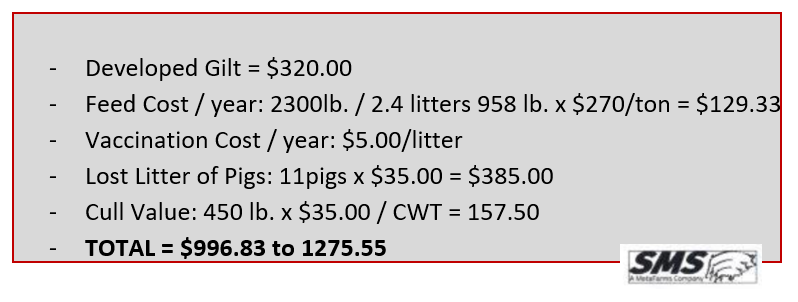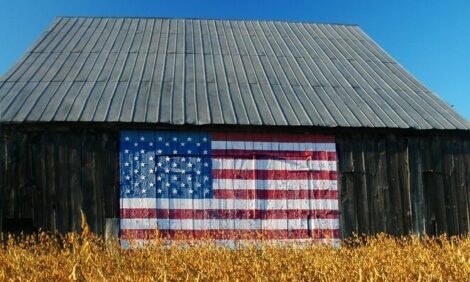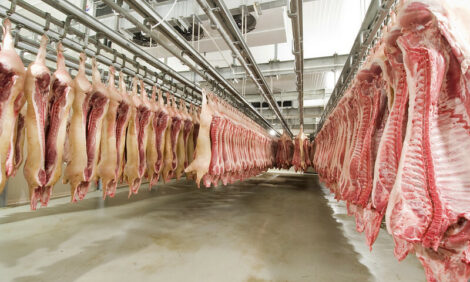



The importance of high lactation feed intake
Selecting pigs for lower FCR leads to reduced feed intake for growing pigs and for lactating sows. This is having a significant negative impact on breeding performance.Increased Milk Production
Obviously, higher lactation feed intake will increase milk production which in turn leads to heavier weaning weights. Research done by Genesus shows for every 1kg (2.2 lb.) increase in daily feed intake for the sow in lactation, litter weaning weight increases by 3.66 kg (8.1 lb.).
Increased Performance of Subsequent Farrowing
Secondly, higher feed intake has a significant effect on performance of subsequent farrowing. For every 1kg (2.2 lb.) extra daily feed intake, total number born in subsequent farrowing increases by 0.27 piglets.
The economic benefits of both of these are clearly understood.
Reducing Sow Mortality and Sow Cull Value
Lastly, higher feed intake has a positive effect reducing sow mortality and sow cull value. These are 2 factors many farms do not even consider. Estimates for the cost of a cull sow are in the range of $900 to $1,150. Dead sows receive no income as they are not sold, they need to be replaced with a gilt and about 45% of sows die pregnant meaning lost production. In many parts of the world now average sow mortality is in the range of 13% to 15% with individual farms over 20%.
Below is a calculation done by Ron Ketchum who is a swine industry professional with over 30 years’ experience in the business. Ron was a founder of Swine Management Services, a swine data analysis company that benchmarked sow and growing herd performance on their database of 1.5 million sows on approximately 900 farms. The chart below shows the true cost of a dead sow to a producer. Extra labor and disposal costs are not included. All values are in USD. The values represent a 5-year industry average. In 2021, the costs are significantly higher.

For cull sows, weight and quality are directly related to the amount received when sent for slaughter. The difference in value for a fit cull sow vs a very skinny sow can be in the $30 to $50 range.
For every 1 kg (2.2 lb.) increase in daily lactation feed intake in gilts, the average parity at which sows are culled increases by 0.26.
Genesus has always understood the negative effects of selection for FCR as a standalone trait on both breeding performance and meat quality. It also negatively impacts pigs' ability to fight disease and also on traits like cannibalism, which is becoming a significant global problem in breeds selected for low FCR.
How to Get High Lactation Feed Intake?
- Use breeding stock selected for high feed intake. Genesus sows will average at least 7.5kg (16.5 lb.) per day over a 21 day lactation (158kg (350 lb.) feed over a 21 day lactation).
- Avoid sows and gilts being over fat at farrowing. This has a significant negative impact on lactation feed intake. Sow callipers (for assessing condition) are a low cost quick and easy way to assess sow condition.
- Do not increase feeding pre-farrowing. For all but very thin sows this has a negative impact on lactation feed intake and actually has zero effect on piglet birth weight.
- Feed sows ad-lib from the day of farrowing. You need a sow with the genetic capacity to do this – low feed intake sows from companies focused on FCR will have low voluntary feed intake in lactation.
- Alternatively, there are new automated technologies to feed sows in lactation that are designed to maximise feed intake.
Labour Crisis
Globally there is a major shortage of people willing to work on pig farms. A key factor in running farms with less people is having an easy-to-manage pig.
When it comes to sow management, many of the reasons for sows that are difficult to manage is low lactation feed intake and the resulting loss of body condition. Yes, there are new technologies being developed to tackle these problems from another angle. Problem with technology is that it requires skilled people to operate and is a cost.
The cost to buy an easy-to-manage gilt vs a difficult-to-manage one is the same!







